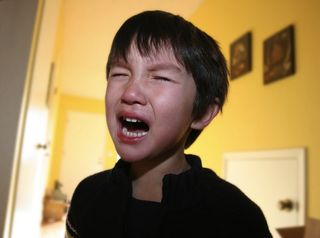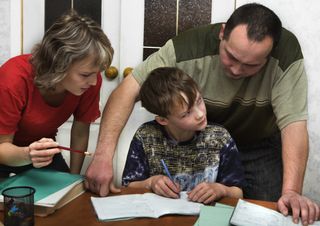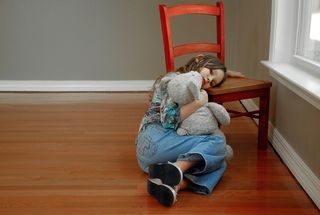How to Do Timeout: 12 Tips from Science

The Science of Timeouts

Research dating back to the 1960s has found that giving kids time-outs is an effective method of discipline, in both the short and long term. The key is to use the method correctly. What that means, researchers said, is to be consistent, set clear parameters and balance punishment with positive parenting techniques like praising kids for their good behavior.
Starting early is important, said California psychologist Ennio Cipani, who makes house calls to train parents on discipline in the home environment.
"You teach your kid how to behave early in life, and it pays off dividends later, Cipani said. That's "because the things you have to deal with and the things you have to do as consequences are a lot less drastic" than if behavioral problems had been allowed to fester, she said. [The Science of Timeouts: How to Make Them Work for Your Kids]
Time-outs are for 2- to 6-year-old kids who are showing aggression and noncompliance, said Mark Roberts, a psychologist at Idaho State University who has studied the discipline method extensively. Some 7- to 12-year-olds with severe behavioral problems might also benefit from time-outs, Roberts said, but the science is less firm with that population; for most older kids, taking away privileges is more effective than time-outs.
Here are the guidelines for a "good" time-out, Cipani and Roberts said:
Context is key.

Time-out is only one tool in the parenting toolbox. When psychologists are called in to help parents cope with serious behavioral problems, the professionals spend as much, if not more time talking about positive parenting strategies than they do about punishments.
"We're teaching parents to be highly responsive to age-appropriate child signals," Roberts said. "That's a fundamental parent-child process that begins at delivery, practically."
In other words, negative reinforcement like time-out must take place against a backdrop full of parental warmth, love and life lessons. Time-out teaches kids not to do certain behaviors, Roberts said. It doesn't teach them about positive behaviors, like how to share, take turns or accept no for an answer when they can't have something that belongs to another child.
"Those are normal social skills that are taught effectively by parents early on, and the vast majority of children entering kindergarten or first grade are really quite skillful," Roberts said.
Keep it simple.

The most frequent mistake parents make with the time-out method is applying it inconsistently, Cipani said. He said he tells parents to pick one or two problem behaviors and to make it clear to kids that time-out will consistently result from those behaviors. Follow-through is important, he said.
He said he tells parents, "When we go after this, we're going to go after this with a gung-ho attitude."
Give clear commands.

When asking a child to do something, get close to them, Roberts said. Kneel and make eye contact if possible, and add a gesture to reinforce the verbal request. "With the older kids, giving them a reason why they should do it is also helpful," Roberts said. [8 Tried-and-True Tips for Talking to Preschoolers]
Don't go up against a difficult child alone.

"Rule of thumb No. 1 is if you try time-out, and this kid shows you intense, impossibly violent resistance, just stop it and get professional help," Roberts said.
Apply the 5-second rule.

After giving a command, stop talking and wait, Robert said. Give kids 5 seconds to process your request, and quickly praise any movement toward compliance.
Give one simple warning.

If, after 5 seconds, a child makes no effort to comply, give one simple warning. The one Roberts said he uses is, "Do X right now, or you're going to have to sit in your time-out chair." Keep it to one warning, though, Roberts said — after that, stop talking, and follow through on the consequence.
… unless the kid is hitting.

Roberts advised that a kid who is hitting or otherwise acting aggressively should be whisked to time-out without a warning. Otherwise, he said, kids learn they can "get their licks in" and avoid consequence as long as they stop after they get called out.
Location, location, location.

The current recommendation for location is a time-out chair, Roberts said, backed up by a time-out in a room if the child won't stay in the chair. The chair works as a primary location, he said, because chairs are everywhere. If a kid misbehaves at a park or Grandma's house, the child will be used to the idea of sitting on a chair for time-out, even if it isn't the usual chair.
For room time-outs, "we tend to use children's bedrooms that they're not afraid of," Roberts said. "We park the parent right at the door to hold the door shut, and they always have the right to enter the room if they hear any dangerous sounds." [9 Weird Ways Kids Can Get Hurt]
Let them out when they're calm, or not.

Some parenting experts say to never let kids out of time-out when they're still screaming and crying. Others say to go by the timer. This one is parent's choice, researchers say. "The data are absolutely mixed," Roberts said. "You can get the same effect by letting the child out when he's noisy as when he's quiet."
When working with kids, Roberts said he starts by requiring that the children be calm and quiet, extending time-outs until the kids settle down. If they don't settle easily, though, he'll adjust the strategy and just go by the clock, he said.
Don't overthink duration.

The science on the duration of an effective time-out isn't strong, Roberts and Cipani say. The oft-cited rule of thumb of 1 minute of time-out per year of a child's age isn't based on any research. "We've demonstrated that 1 minute works, 3 minutes works, 4 minutes works," Cipani said. In general, Roberts said, 2 to 5 minutes is plenty.
Sign up for the Live Science daily newsletter now
Get the world’s most fascinating discoveries delivered straight to your inbox.

Stephanie Pappas is a contributing writer for Live Science, covering topics ranging from geoscience to archaeology to the human brain and behavior. She was previously a senior writer for Live Science but is now a freelancer based in Denver, Colorado, and regularly contributes to Scientific American and The Monitor, the monthly magazine of the American Psychological Association. Stephanie received a bachelor's degree in psychology from the University of South Carolina and a graduate certificate in science communication from the University of California, Santa Cruz.












